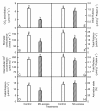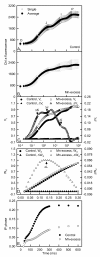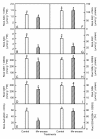Effects of manganese-excess on CO2 assimilation, ribulose-1,5-bisphosphate carboxylase/oxygenase, carbohydrates and photosynthetic electron transport of leaves, and antioxidant systems of leaves and roots in Citrus grandis seedlings
- PMID: 20205939
- PMCID: PMC2848762
- DOI: 10.1186/1471-2229-10-42
Effects of manganese-excess on CO2 assimilation, ribulose-1,5-bisphosphate carboxylase/oxygenase, carbohydrates and photosynthetic electron transport of leaves, and antioxidant systems of leaves and roots in Citrus grandis seedlings
Abstract
Background: Very little is known about the effects of manganese (Mn)-excess on citrus photosynthesis and antioxidant systems. Seedlings of sour pummelo (Citrus grandis) were irrigated for 17 weeks with nutrient solution containing 2 microM (control) or 500 microM (excess) MnSO4. The objective of this study were to understand the mechanisms by which Mn-excess leads to a decrease in CO2 assimilation and to test the hypothesis that Mn-induced changes in antioxidant systems differ between roots and leaves.
Results: Mn-excess decreased CO2 assimilation and stomatal conductance, increased intercellular CO2 concentration, but did not affect chlorophyll (Chl) level. Both initial and total ribulose-1,5-bisphosphate carboxylase/oxygenase (Rubisco) activity in Mn-excess leaves decreased to a lesser extent than CO2 assimilation. Contents of glucose, fructose, starch and total nonstructural carbohydrates did not differ between Mn-excess leaves and controls, while sucrose content was higher in the former. Chl a fluorescence (OJIP) transients from Mn-excess leaves showed increased O-step and decreased P-step, accompanied by positive L- and K-bands. Mn-excess decreased maximum quantum yield of primary photochemistry (Fv/Fm) and total performance index (PItot,abs), but increased relative variable fluorescence at I-steps (VI) and energy dissipation. On a protein basis, Mn-excess leaves displayed higher activities of monodehydroascorbate reductase (MDAR), glutathione reductase (GR), superoxide dismutase (SOD), catalase (CAT) and guaiacol peroxidase (GPX) and contents of antioxidants, similar ascorbate peroxidase (APX) activities and lower dehydroascorbate reductase (DHAR) activities; while Mn-excess roots had similar or lower activities of antioxidant enzymes and contents of antioxidants. Mn-excess did not affect malondialdehyde (MDA) content of roots and leaves.
Conclusions: Mn-excess impaired the whole photosynthetic electron transport chain from the donor side of photosystem II (PSII) up to the reduction of end acceptors of photosystem I (PSI), thus limiting the production of reducing equivalents, and hence the rate of CO2 assimilation. Both the energy dissipation and the antioxidant systems were enhanced in Mn-excess leaves, while the antioxidant systems in Mn-excess roots were not up-regulated, but still remained high activity. The antioxidant systems in Mn-excess roots and leaves provided sufficient protection to them against oxidative damage.
Figures









Similar articles
-
Antagonistic actions of boron against inhibitory effects of aluminum toxicity on growth, CO2 assimilation, ribulose-1,5-bisphosphate carboxylase/oxygenase, and photosynthetic electron transport probed by the JIP-test, of Citrus grandis seedlings.BMC Plant Biol. 2009 Aug 1;9:102. doi: 10.1186/1471-2229-9-102. BMC Plant Biol. 2009. PMID: 19646270 Free PMC article.
-
CO2 assimilation, ribulose-1,5-bisphosphate carboxylase/oxygenase, carbohydrates and photosynthetic electron transport probed by the JIP-test, of tea leaves in response to phosphorus supply.BMC Plant Biol. 2009 Apr 21;9:43. doi: 10.1186/1471-2229-9-43. BMC Plant Biol. 2009. PMID: 19379526 Free PMC article.
-
Phosphorus alleviates aluminum-induced inhibition of growth and photosynthesis in Citrus grandis seedlings.Physiol Plant. 2009 Nov;137(3):298-311. doi: 10.1111/j.1399-3054.2009.01288.x. Physiol Plant. 2009. PMID: 19832942
-
Photosynthetic carbon reduction and carbon oxidation cycles are the main electron sinks for photosystem II activity during a mild drought.Ann Bot. 2002 Jun;89 Spec No(7):887-94. doi: 10.1093/aob/mcf064. Ann Bot. 2002. PMID: 12102514 Free PMC article. Review.
-
Physiological and molecular alterations in plants exposed to high [CO2] under phosphorus stress.Biotechnol Adv. 2015 May-Aug;33(3-4):303-16. doi: 10.1016/j.biotechadv.2015.03.011. Epub 2015 Mar 20. Biotechnol Adv. 2015. PMID: 25797341 Review.
Cited by
-
A plant's perception of growth-promoting bacteria and their metabolites.Front Plant Sci. 2024 Jan 24;14:1332864. doi: 10.3389/fpls.2023.1332864. eCollection 2023. Front Plant Sci. 2024. PMID: 38328622 Free PMC article. Review.
-
Citrus Physiological and Molecular Response to Boron Stresses.Plants (Basel). 2021 Dec 23;11(1):40. doi: 10.3390/plants11010040. Plants (Basel). 2021. PMID: 35009043 Free PMC article. Review.
-
The mitochondrial alternative oxidase pathway protects the photosynthetic apparatus against photodamage in Rumex K-1 leaves.BMC Plant Biol. 2012 Mar 20;12:40. doi: 10.1186/1471-2229-12-40. BMC Plant Biol. 2012. PMID: 22429403 Free PMC article.
-
Effects of phosphorus deficiency on the absorption of mineral nutrients, photosynthetic system performance and antioxidant metabolism in Citrus grandis.PLoS One. 2021 Feb 17;16(2):e0246944. doi: 10.1371/journal.pone.0246944. eCollection 2021. PLoS One. 2021. PMID: 33596244 Free PMC article.
-
Aluminum Toxicity-Induced Alterations of Leaf Proteome in Two Citrus Species Differing in Aluminum Tolerance.Int J Mol Sci. 2016 Jul 21;17(7):1180. doi: 10.3390/ijms17071180. Int J Mol Sci. 2016. PMID: 27455238 Free PMC article.
References
-
- Mukhopadhyay MJ, Sharma A. Manganese in cell metabolism of higher plants. Bot Rev. 1991;57:117–149. doi: 10.1007/BF02858767. - DOI
-
- Foy CD. In: Soil Acidity and Liming. 2. Adams F, editor. Madison: American Society of Agronomy; 1984. Physiological effects of hydrogen, aluminum, and manganese toxicities in acid soils; pp. 57–97.
-
- Ohki K. Manganese deficiency and toxicity effects on photosynthesis, chlorophyll, and transpiration in wheat. Crop Sci. 1985;25:187–191.
Publication types
MeSH terms
Substances
LinkOut - more resources
Full Text Sources
Miscellaneous

